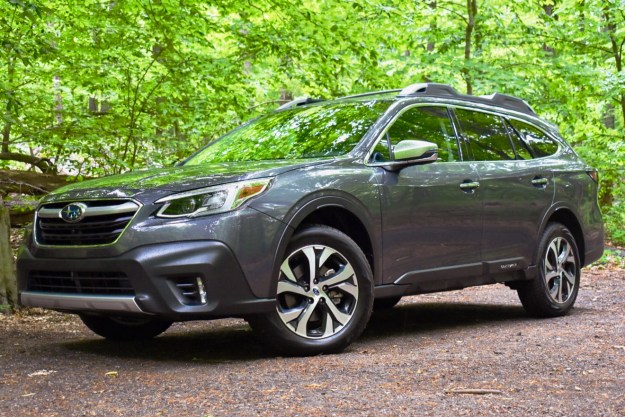
- Powerful turbocharged engine
- A big screen that justifies its size
- Comfortable ride
- Well-executed driver-assist tech
- Price climbs quickly with options
The Subaru Outback has thrived by embracing the motto “if you can’t beat ‘em, join ‘em.” In the 1990s, Subaru took one of its all-wheel drive station wagons and added some SUV-like styling details to create the Outback. The model has remained popular even as other wagons have been squeezed out of the market by SUVs.
The Outback remains a compelling SUV alternative, thanks in part to a capacious cargo area and all-wheel drive traction. Redesigned for the 2020 model year, the Outback adds more tech to the mix. The wagon is available with an 11.6-inch touchscreen and Subaru’s DriverFocus system, which uses a driver-facing camera to detect distractions.
Pricing for the 2020 Outback starts at $27,655, but our test car was a range-topping Touring XT model priced at $40,705. It had every bell and whistle, including the big touchscreen, DriverFocus, and a more powerful turbocharged engine.
Design and interior
As before, the 2020 Subaru Outback is essentially a wagon version of the Subaru Legacy sedan (which was also redesigned for the 2020 model year). Besides getting a rear hatch instead of a trunk, the Outback dons plastic body cladding for a more SUV-like look. The Outback also rides fairly high for a car, again, to make it feel more like an SUV. Its 8.7 inches of ground clearance is actually more than a Honda CR-V or Toyota RAV4.
The interior is typical Subaru, with a simple yet sensible layout.
Despite being redesigned, you’d be hard-pressed to tell the 2020 Outback apart from its predecessor. The new model is also pretty close in size to the 2019 Outback. It’s slightly wider and longer, but with an identical wheelbase. Under the skin, the 2020 Outback rides on the Subaru Global Platform that underpins most of the automaker’s other models. Subaru claims the 2020 Outback is 70% stiffer in torsional rigidity than its predecessor, which helps improve handling and creates a more solid feel. The new model can also absorb more than 40% more energy in front and side impacts, according to Subaru.

The interior is typical Subaru, with a simple yet sensible layout. Our Touring test car was fully decked out with leather upholstery, but the materials did not feel worthy of this car’s $40,000 price tag. Like many other automakers, Subaru also chose to use piano black plastic trim, which scratches and smudges easily and, in our experience, produces a lot of glare on sunny days.
In terms of interior space, the Outback compares favorably to the compact crossovers you can buy for similar money. It has more front legroom than a Honda CR-V or Toyota RAV4 and, with its rear seats folded, more cargo space than a Ford Escape. The Outback trails Subaru’s own Forester, however, thanks to the latter’s taller, boxier body.
Tech, infotainment, and driver assist
The big tech news for 2020 is an available 11.6-inch portrait-oriented touchscreen. The screen is standard on all Outback trim levels except the base model (which gets a 7.0-inch touchscreen), while Apple CarPlay and Android Auto are standard across the board.
Many automakers have installed big screens, but most don’t seem to know what to do with all of that real estate. Subaru has done something smart and straightforward — it just made the menu icons bigger. You don’t have to squint to see anything on this screen, and the big icons are easier to find while driving. Subaru also placed icons for climate control at the bottom of the screen — about where analog controls would normally be — and included an analog volume knob, which is still the best tool for that job.

The 2020 Outback also gets Subaru’s EyeSight driver-assist tech, which uses forward-facing cameras mounted near the rearview mirror, rather than the radar units used by most other automakers. Adaptive cruise control with lane centering is standard, while blind spot monitoring, lane change assist, and rear cross traffic alert are optional extras. The Honda CR-V and Toyota RAV4 also get standard adaptive cruise control. It costs extra on the Ford Escape, but Ford’s system includes a stop-and-go function.
Subaru did something smart and straightforward — it just made the menu icons bigger.
On the highway, adaptive cruise control excelled at maintaining a steady pace, but was slow to react when cars cut in abruptly. In a straight line, the lane-centering feature did its job with only the gentlest of steering inputs, but had trouble with even the slightest of curves. These are issues we’ve noticed with most competitor systems, however, and overall performance was good for a vehicle in this price range that lacks the more elaborate sensor suites of high-end models.
Subaru is one of a handful of automakers (along with BMW and Cadillac) to use a driver-facing camera to ensure that people don’t use these tech features irresponsibly. The DriverFocus system, which debuted in the Forester, sends audio and video alerts if drivers take their eyes off the road. As with the Forester, we found DriverFocus to be fairly unobtrusive, with no false alarms.
Driving experience
Another big change for 2020 is under the hood. For the first time since 2009, the Outback is available with a turbocharged four-cylinder engine. Like all Subaru engines, a “boxer” configuration allows this engine to sit lower in the chassis, helping to improve handling. Shared with the Ascent, the turbo engine produces 260 horsepower and 277 pound-feet of torque. You have to pay extra for that power. Base Outbacks get a naturally aspirated 2.5-liter boxer-four from the Forester, making 182 hp and 176 lb-ft.
The base engine boasts competitive numbers for this segment, but the optional turbo engine is the Outback’s party piece. Only the Jeep Cherokee, which is available with a 270hp 2.0-liter turbo-four, offers a similar combination of power and utility in a vehicle of this size.

Regardless of engine, the Outback gets a continuously variable transmission (CVT) and all-wheel drive. Like the Ascent and Forester, the all-wheel drive system also gets an “X-Mode” designed for light off-roading. This doesn’t transform the Outback into a hardcore off-roader, but it’s handy for dirt roads and deep snow.
The optional turbo engine is the Outback’s party piece.
On the road, the turbocharged engine’s extra power was a godsend when overtaking other vehicles. However, the engine and transmission didn’t always seem to be on the same page, yielding uneven power delivery that we didn’t recall from the same combination in the larger Ascent. Despite being smaller and having a lower center of gravity, the Outback also didn’t have the Ascent’s cornering prowess. Handling wasn’t bad, but the Outback’s limits felt much lower than those of its big sibling.
Subaru also struck a good balance between handling and ride quality. The Outback felt downright luxurious, soaking up bumps without feeling floaty and disconnected from the road. A comfortable ride will likely be more important to the person that buys this car than a few extra degrees of handling sharpness. If you want a sporty Subaru, buy a WRX STI.
Gas mileage and safety
Our turbo test car is rated at 26 mpg combined (23 mpg city, 30 mpg highway). That’s a significant improvement over the old six-cylinder Outback, which could only muster 22 mpg combined, and a little bit behind a turbocharged Honda CR-V (29 mpg combined) and non-hybrid Toyota RAV4 (28 mpg combined). Over a week of driving, we averaged 22 mpg, according to the car’s trip computer.
The 2020 Outback received the highest Top Safety Pick+ rating from the Insurance Institute for Highway Safety, and a five-star overall rating from the National Highway Traffic Safety Administration.
Subaru offers a three-year, 36,000-mile, basic warranty and a five-year, 60,000-mile powertrain warranty. That’s about average for a mainstream brand, although Hyundai and Kia offer longer warranty terms. Subaru also has an excellent reputation for reliability.
How DT would configure this car
Our ideal Outback would be equipped in a similar fashion as the car we tested. It may be a significant step up in price, but if you want tech, the Touring trim level is the one to get. The Touring is the only trim level to get the DriverFocus anti-distraction feature as standard equipment. It also gets the 11.6-inch touchscreen, as well as leather upholstery, heated and ventilated front seats, and a power moonroof.

We would also shell out for the turbocharged engine. While we didn’t get an opportunity to try the base engine, our experience with it in the Forester indicates that it would be the wrong choice. The Forester felt sluggish with that engine, and it’s unlikely that things would be different in the heavier Outback.
Our take
The Subaru Outback is a familiar sight on roads in the Northeast and Northwest, but the latest version aims for much broader appeal. The Outback still offers great utility and all-wheel drive traction in an understated package, but now with more tech and a better, turbocharged engine.
With the last-generation Outback, buyers had choose between an economical but underpowered four-cylinder engine, and a powerful but thirsty six-cylinder. The 2020 Outback’s turbo-four splits the difference, offering a much-needed boost in power without destroying gas mileage.
No one bought a 2019 Outback for its infotainment system, but the 2020 model gets one of the biggest screens in a mainstream car. Unlike rivals Ford and Toyota, Subaru also made effective use of that big screen. Subaru’s EyeSight driver-assist tech is still among the best in this price range, and the DriverFocus feature helps ensure it won’t be misused.
As the only wagon from a mainstream brand still on the market, the Outback mainly competes against SUVs like the Honda CR-V, Toyota RAV4, and Ford Escape. The Subaru is close to those competitors on interior space and gas mileage, showing just how close they are to conventional cars. The Outback also has a much stronger tech game, thanks to its 11.6-inch touchscreen and EyeSight and DriverFocus driver aids, and its 260hp engine adds a fun factor most other small SUVs lack.
Should you get one?
Yes. The Outback offers an impressive combination of tech and utility.
Editors' Recommendations
- 2022 Volvo V90 Cross Country first drive review: Android on board
- Subaru Crosstrek vs. Subaru Outback
- 2020 Subaru Impreza gets new look and more tech without the inflated price tag
- Subaru has already recalled the 2020 Outback and Legacy over brake problems
- Fresh off a redesign, the 2020 Subaru Forester adds more safety tech



